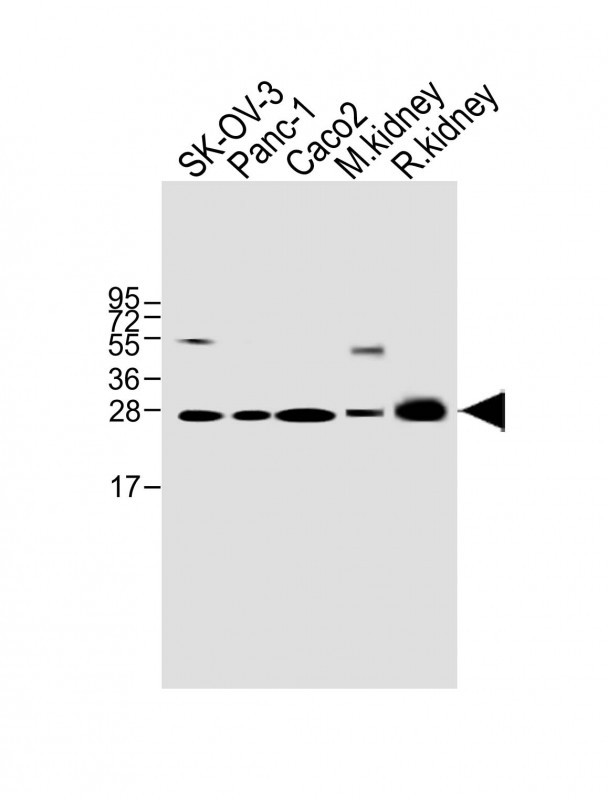TMEM97 Antibody (N-term)
Purified Rabbit Polyclonal Antibody (Pab)
- 产品详情
- 实验流程
- 背景知识
Application
| WB, E |
|---|---|
| Primary Accession | Q5BJF2 |
| Reactivity | Human, Rat, Mouse |
| Host | Rabbit |
| Clonality | polyclonal |
| Isotype | Rabbit IgG |
| Calculated MW | 20848 Da |
| Gene ID | 27346 |
|---|---|
| Other Names | Transmembrane protein 97, Protein MAC30, TMEM97, MAC30 |
| Target/Specificity | This TMEM97 antibody is generated from a rabbit immunized with a KLH conjugated synthetic peptide between 22-56 amino acids from the N-terminal region of human TMEM97. |
| Dilution | WB~~1:1000 E~~Use at an assay dependent concentration. |
| Format | Purified polyclonal antibody supplied in PBS with 0.05% (V/V) Proclin 300. This antibody is purified through a protein A column, followed by peptide affinity purification. |
| Storage | Maintain refrigerated at 2-8°C for up to 2 weeks. For long term storage store at -20°C in small aliquots to prevent freeze-thaw cycles. |
| Precautions | TMEM97 Antibody (N-term) is for research use only and not for use in diagnostic or therapeutic procedures. |
| Name | TMEM97 (HGNC:28106) |
|---|---|
| Function | Sigma-2 receptor which contributes to ameliorate dysfunctional cellular processes and slow degenerative progression by regulating cell functions including cholesterol biosynthesis/trafficking, membrane trafficking, autophagy, lipid membrane-bound protein trafficking, and receptor stabilization at the cell surface (Probable) (PubMed:19583955, PubMed:23922215, PubMed:25620095, PubMed:27378690, PubMed:28559337, PubMed:30443021, PubMed:34233061, PubMed:34799735, PubMed:35970844). Forms a ternary complex with PGRMC1 receptor and low density lipoprotein receptor/LDLR at the plasma membrane, which increases LDLR-mediated LDL cholesterol internalization (PubMed:30443021). Decreases lysosomal sterol transporter NPC1 availability to the cell, probably through NPC1- binding, hence controlling lipid transport, including cholesterol and LBPA, outside of late endosome/lysosome (PubMed:19583955, PubMed:27378690). Binds regio- and stereoselective ligand 20(S)- hydroxycholesterol (20(S)-OHC) which enhances TMEM97-NPC1 interaction and decreases TMEM97-PGRMC1 and TMEM97-TSPO interactions, thereby linking OHC binding to cholesterol homeostasis (PubMed:34799735, PubMed:37047353). Also able to bind cholesterol (By similarity). Binds histatin 1 (Hst 1)/HN1 salivary peptide at the ER membrane, which is critical for increasing mitochondria-ER contacts and stimulating Hst1 wound healing properties (PubMed:34233061, PubMed:35970844). May alter the activity of some cytochrome P450 proteins (PubMed:22292588). Although shows homologies with sterol isomerases (EXPERA domain), not able to catalyze sterol isomerization (Probable) (PubMed:34880501). However, may act as sensors of these molecules (Probable) (PubMed:34880501). Acts as a quality control factor in the ER, promoting the proteolytic degradation of nonproductive and extramitochondrial precursor proteins in the ER membrane thus removing them from the ER surface (By similarity). |
| Cellular Location | Rough endoplasmic reticulum membrane; Multi-pass membrane protein. Nucleus membrane; Multi- pass membrane protein. Note=Localized at cell membrane and in lysosomes in sterol-depleted cells when expression of endogenous TMEM97 is stimulated (PubMed:19583955). Localized at cell membrane, probably in lipid rafts, in serum-starved conditions (PubMed:30443021) |
| Tissue Location | Widely expressed in normal tissues. Expressed in pancreatic, renal, breast, colon, ovarian surface epithelial (OSE) cells. Highly expressed in various proliferating cancer cells (PubMed:23922215). |
Research Areas
For Research Use Only. Not For Use In Diagnostic Procedures.
Application Protocols
Provided below are standard protocols that you may find useful for product applications.
BACKGROUND
Plays a role as a regulator of cellular cholesterol homeostasis.
REFERENCES
Murphy M.,et al.Cell Growth Differ. 4:715-722(1993).
Ota T.,et al.Nat. Genet. 36:40-45(2004).
Kayed H.,et al.Histol. Histopathol. 19:1021-1031(2004).
Wilcox C.B.,et al.BMC Cancer 7:223-223(2007).
Bartz F.,et al.Cell Metab. 10:63-75(2009).
终于等到您。ABCEPTA(百远生物)抗体产品。
点击下方“我要评价 ”按钮提交您的反馈信息,您的反馈和评价是我们最宝贵的财富之一,
我们将在1-3个工作日内处理您的反馈信息。
如有疑问,联系:0512-88856768 tech-china@abcepta.com.























 癌症的基本特征包括细胞增殖、血管生成、迁移、凋亡逃避机制和细胞永生等。找到癌症发生过程中这些通路的关键标记物和对应的抗体用于检测至关重要。
癌症的基本特征包括细胞增殖、血管生成、迁移、凋亡逃避机制和细胞永生等。找到癌症发生过程中这些通路的关键标记物和对应的抗体用于检测至关重要。 为您推荐一个泛素化位点预测神器——泛素化分析工具,可以为您的蛋白的泛素化位点作出预测和评分。
为您推荐一个泛素化位点预测神器——泛素化分析工具,可以为您的蛋白的泛素化位点作出预测和评分。 细胞自噬受体图形绘图工具为你的蛋白的细胞受体结合位点作出预测和评分,识别结合到自噬通路中的蛋白是非常重要的,便于让我们理解自噬在正常生理、病理过程中的作用,如发育、细胞分化、神经退化性疾病、压力条件下、感染和癌症。
细胞自噬受体图形绘图工具为你的蛋白的细胞受体结合位点作出预测和评分,识别结合到自噬通路中的蛋白是非常重要的,便于让我们理解自噬在正常生理、病理过程中的作用,如发育、细胞分化、神经退化性疾病、压力条件下、感染和癌症。






